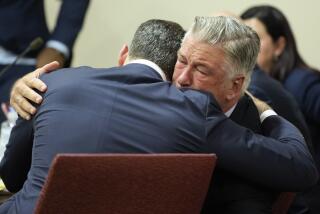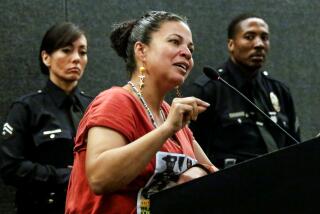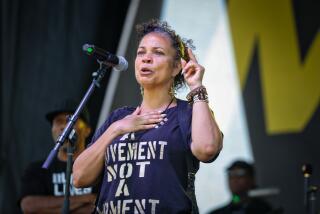Sniper Suspect Steps Down After Two Days as His Own Lawyer
- Share via
VIRGINIA BEACH, Va. — After acting as his own lawyer for two days, sniper suspect John Allen Muhammad handed control of his case back to his attorneys on Wednesday.
Circuit Court Judge LeRoy F. Millette Jr., who is presiding over the case, said Muhammad had decided it was “in his best interest that he no longer represent himself.” Muhammad is accused of orchestrating 13 attacks in the Washington, D.C., area a year ago that claimed 10 lives.
Muhammad’s alleged partner in the attacks, Lee Boyd Malvo, appeared in court, and a victim and a witness identified him as playing a role in at least one of the Washington attacks. They are also tied to shootings in Alabama, Georgia, Louisiana, Arizona and Washington state.
Muhammad, 42, is charged with capital murder in the slaying of Dean Harold Meyers at a gas station in Manassas, Va., a suburb of Washington. Under Virginia law, to make it a capital case, the prosecution must prove that he killed more than one person, so evidence is being presented in 11 of the shootings.
On Monday, Muhammad stunned the courtroom by asking the judge whether he could represent himself, arguing that he was the best person to speak on his behalf. But on Wednesday, he sat quietly alongside his attorneys and nursed a toothache.
With the defense lawyers in action, the tone of the trial changed considerably.
While Muhammad was polite, rambling and sometimes bumbling as he cross-examined witnesses, his attorneys were aggressive in cross-examinations, trying to cast doubt on statements by survivors and eyewitnesses. They also frequently objected to evidence and testimonies that the prosecution wanted to present.
On Wednesday, the jury heard testimony from Muhammad Rashid, who was wounded in an attack in Brandywine, Md., on Sept. 15, 2002. Rashid raised the possibility of two gunmen when he testified that he heard shots fired from behind, before turning and spotting a gunman with a pistol aimed at him.
Rashid said he got a good look at his assailant, who was standing only about 5 feet away. After Malvo was escorted into the courtroom, Rashid identified Malvo as the shooter.
In cross-examining testimony from Rashid, Muhammad’s attorneys suggested that it was too dark for Rashid to see clearly or identify his assailant.
A tape of Rashid’s anguished 911 call for help after he was shot was played in court.
Prosecutors later turned to a shooting on Sept. 21, 2002, in Montgomery, Ala., that killed Claudine Parker, 52, and seriously wounded Kellie Adams, 24, two employees of a state-run liquor store who were attacked while closing up for the night.
Adams appeared on the witness stand to describe her injuries and what little she remembered of the attack. One of her vocal cords was paralyzed and, after six surgeries, she still uses a tube to help her breathe.
James Gray, a newspaper owner and former tennis professional, told the jury that he was nearby when he heard shots and saw police chasing a young man who was fleeing the scene. He testified that he joined in the pursuit and that he came “face to face” with the assailant in a narrow alley near the liquor store before the man got away.
“I saw his eyes,” Gray said. “I saw he was staring at me. His eyes were big and round and he looked wild, like he was in some kind of frenzy.”
When Malvo was brought into court, Gray asked if he would turn so he could see his profile. After a moment, Gray exclaimed: “That’s him!” Gray then clasped his hands to his face, crying and said: “Oh, Lord.” Muhammad’s lawyer tried to raise doubts about the identification, but Gray did not budge.
Meanwhile, legal experts said Muhammad clearly set back his own case during the two days he acted as his own lawyer.
On Tuesday, prosecutors were able to breeze through testimony by nearly a dozen witnesses. Despite occasional objections, Muhammad sat silently at moments when defense lawyers would likely have been asserting procedural and evidentiary weaknesses in the prosecution’s case.
At the same time, Muhammad’s two-day tryout as his own lawyer provided intriguing peeks into the inner world of the 1991 Persian Gulf War veteran who is described by prosecutors as the “captain” of a two-man “killing team.” Muhammad proved to be a courteous, deferential counselor. He even tried to put Paul LaRuffa, one of his alleged victims, at ease by claiming he did not intend to “disrespect you.”
If Muhammad gained anything from his stint as a lawyer, it might have humanized him to the jury, said Marvin Miller, a northern Virginia defense specialist. “It’s possible he could have connected with the jury in a way he wouldn’t have by sitting at the counsel table. We won’t know until the trial’s over.”
However, John Zwerling, a member of the board of directors of the National Assn. of Criminal Defense Lawyers, said Muhammad’s decision to put his defense back in the hands of his attorneys “may very well be a decision that saved his life.”
*
Times staff writer Stephen Braun contributed to this report.
More to Read
Sign up for Essential California
The most important California stories and recommendations in your inbox every morning.
You may occasionally receive promotional content from the Los Angeles Times.













